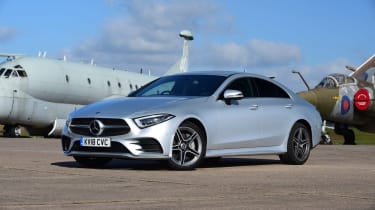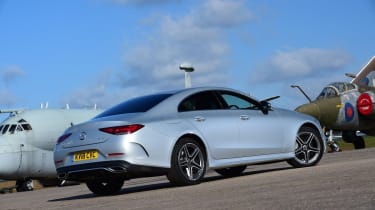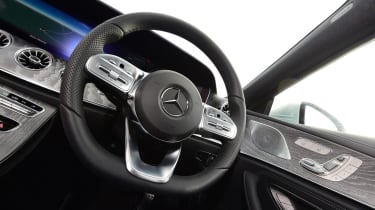Used Mercedes CLS (Mk3, 2017-date) review: expensive, but a joy to drive
A full used buyer’s guide on the Mercedes CLS covering the CLS Mk3 that has been on sale since 2017
Verdict
The third-generation Mercedes CLS isn’t quite as well rounded as its predecessor because there was no Shooting Brake (estate) option; the CLS Mk2 hadn’t proved popular enough to warrant developing another one. But this aside, the CLS is one of those cars that if you can afford to buy and run it, there’s no significant objective reason not to consider doing so; this is a car that’s incredibly safe, enjoyable (as well as easy) to drive, and provides effortless performance. Whereas the first two generations of CLS were four-seaters, the third take came with space for three in the back to boost its usability. However, this isn’t a car that’s designed for transporting five adults over long distances; think of it as a plush family car for those with two or three children.
When Mercedes introduced the original CLS two decades ago, it caused a stir with its swoopy design and luxurious cabin. Under the skin it was little more than a poshed-up E-Class, but that was no bad thing, because donor cars don’t come much more accomplished than Merc’s executive.
As a premium model within the Mercedes range, the CLS came with the very best of everything with regard to engines, transmissions and equipment. The CLS was more of a hit than Mercedes had anticipated, so it was no surprise when a second-generation model was launched in 2011, with the third take appearing six years later. It was costly when new, and even now there’s no such thing as a cheap CLS Mk3, but if you’re after a stylish and luxurious family car, then look no further.
History
The CLS Mk3 hit UK roads in summer 2017, with three six-cylinder engines on offer. There was one petrol option, the 362bhp twin-turbo 3.0-litre CLS 450, and alongside it was a pair of diesels with a new 2,925cc in-line six. The entry-level model was the 282bhp CLS 350 d, and above this was the 335bhp CLS 400 d.
More reviews
For those who wanted more, the 429bhp AMG CLS 53 joined the range in January 2018; and for those who wanted less, the 295bhp four-cylinder CLS 350 appeared in August 2018. Soon after, a four-cylinder diesel mild hybrid also arrived, the 242bhp CLS 300 d. A facelifted CLS launched in July 2021, with a refreshed exterior design and new colour options, while some new option packages were added to the CLS 53.
Which one should I Buy?
No CLS is lacking, because even entry-level models deliver decent performance, equipment and refinement. However, while the four-cylinder engines are sufficient, the six-cylinder models offer the true luxury experience. The diesels are reasonably economical as well as wonderfully muscular, plus they’re all ULEZ compliant.
Most CLSs have four-wheel drive, and we’d take one of these over the rear-drive alternative for security in adverse conditions, although they’re slightly thirstier. Aside from a limited-run Night Edition, all CLSs came in AMG Line form, with 19-inch alloys, Active Parking Assist including a rear-view camera, a bodykit, selectable driving modes, leather trim, heated front seats. The CLS 53 also came with adaptive damping, the Premium Plus package (see Checklist) and a performance exhaust system.
Alternatives to the Mercedes CLS
The CLS doesn’t sit in a segment that’s overflowing with options, although there are some alluring contenders, including the Audi A7 Sportback. Unlike the CLS, this offers hatchback practicality along with a superb cabin, some impressive engines and excellent build quality.
The Porsche Panamera leads the class in terms of driving pleasure, comes with some fabulous engines, and its cabin is even more sumptuous than the Merc’s. If you’re fine with having a swoopy saloon rather than a hatchback, the BMW 6 Series Gran Coupé provides everything that the Audi A7 does, but it’s more enjoyable to drive, and like the A7 and CLS, four-wheel drive is available.
Also, don’t discount the idea of buying the car that shares tech with the CLS. The E-Class is plentiful, built to just as high a standard and equally luxurious, plus it’s more practical, but less stylish.
What to look for
Budget option
Mercedes offered the four-cylinder CLS 220 d as an entry-level model in Europe, but this wasn’t sold in the UK.
Gearbox
None of the CLS range came with the option of a manual gearbox. The only transmission available with all of them was a nine-speed auto.
Extras
Optional Premium Plus pack added around view, a 13-speaker hi-fi, upgraded infotainment, an opening glass sunroof and more.
Towing
With a kerbweight of anywhere between 1,825kg and 1,980kg, and the ability to pull up to 1,900kg, the CLS makes a great tow vehicle.
Interior
Mercedes did such an impressive job with the CLS’s cabin that you could be forgiven for wondering what the point is of an S-Class. The CLS has it all: premium materials, plenty of standard equipment, excellent seats and impressive ergonomics.
Even without options, the trim and infotainment are superb, but cars with the Premium Plus package come with even better multimedia, which includes Android Auto, Apple CarPlay and Road Sign Assist, and better navigation.
Where the S-Class does score more highly is with rear-seat space; not only is the CLS tight for three abreast, but headroom is limited because of the sloping roofline, although the CLS Mk3 isn’t as compromised as the previous generations. Boot space is good, at 520 litres for diesel models, but 490 litres for petrol editions because these have a bigger fuel tank (80 litres instead of 66 litres).
Prices
Most cars are diesels, with the 350 d the most popular. If you prefer something with a petrol engine, you’ll have to search to find your perfect CLS as all versions are unusual.
To check prices on a specific model head over to our valuation tool.
Recalls
The CLS Mk3 has been recalled on seven occasions so far, the first time in September 2019 because of radar software glitches; some cars made up to July 2019 were affected. Coolant pump short circuits led to recall two, in November 2019, then in August 2020 two campaigns were launched. The first was because of faulty seatbelt buckles, the second was down to turbocharger oil leaks, which could lead to the car catching fire.
Seatbelt warnings failing to work properly led to the next recall, then in 2022 there were two more. The first came in February because of faulty ECU software in some cars, while the second was issued in September because of potential short circuits in the transmission wiring loom. Apart from the coolant pump recall, all of these campaigns affected a wide range of Mercedes models.
Running costs
The CLS needs to be serviced every 12 months or 12,500 miles. Services alternate between minor (A) and major (B), but there isn’t a set schedule for the replacement of some items, with these cars using a condition-based system, so they’re renewed only when necessary. As a result, the A service can cost anywhere between £316 and £600, while the B service is priced at £462.
A replacement air filter costs around £60 and needs to be fitted every three years, while fuel filters cost about twice as much and need to be replaced every three years on diesels, but 10 years on petrols. The automatic gearbox needs a service at every 77,500 miles, fresh brake fluid is required every other year, while the coolant needs to be renewed every 10 years. All CLS engines are chain driven, so there are no cambelts to replace.
Driver Power owner satisfaction
The CLS is too niche to have appeared in our Driver Power new or used-car surveys. However, this version is based on the same platform as the E-Class Mk5, which came 68th out of 75 in our 2022 Driver Power New Car survey; last year it moved up to 43rd place. The high spots are the interior design and quality, the infotainment and the gearbox. The biggest black mark is for high running costs.






